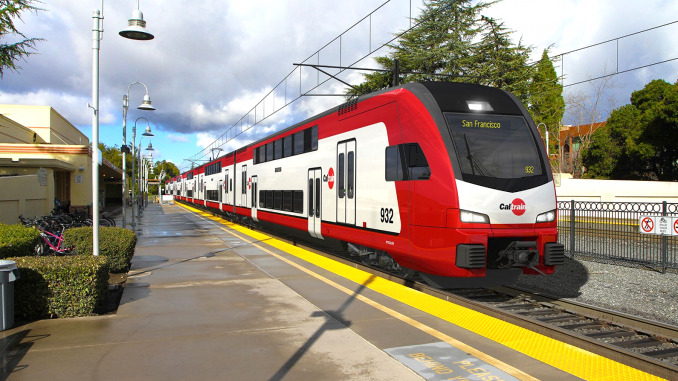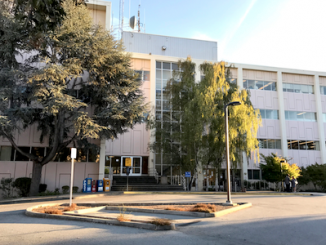
BY EMILY MIBACH
Daily Post Staff Writer
Caltrain is studying the idea of adding two more tracks from Palo Alto’s California Avenue station to Mountain View, bringing the number of tracks in that area to four.
The two additional tracks would be “passing tracks,” where trains would idle or travel more slowly while the pair of regular parallel tracks would be used by express trains or high-speed rail.
Caltrain is also looking at adding passing tracks in San Mateo and Redwood City, according to a Dec. 20 presentation to a group of local elected officials called the Caltrain Policy Maker Group.
The Dec. 20 presentation said that Caltrain is looking to increase the number of trains that run each hour during the busiest times of day to either 12 or 16.
If the Caltrain board goes forward with the 12-train option, that would also require a total of three miles of passing track to be added along the corridor.
Caltrain CEO Jim Hartnett told the Post in a Dec. 10 interview that it’s up to the California High-Speed Rail Authority to study the need for passing tracks, and he said there may not be any passing tracks, based on HSR’s environmental impact report.
Hartnett also said that it’s possible that passing tracks would only be added at particular train stations rather than adding miles of parallel tracks along the Caltrain corridor.
Two options
Caltrain is working on a “business plan” that gives two options for the passing tracks.
One option calls for passing tracks in three spots — from Hayward Park to Hillsdale in San Mateo, another one about the length of the Redwood City station and a third at a “northern Santa Clara County station.”
The other option proposes three longer sets of passing tracks — one from South San Francisco to Millbrae, the second from San Mateo to Redwood City, and the third from California Avenue in Palo Alto to Mountain View.
In 2009, large numbers of mid-Peninsula residents turned against high-speed rail, and one of their objections is that the proposal would result in four sets of tracks along the Caltrain cooridor, two for Caltrain and two for high-speed rail.
Remember the ‘blended plan’?
In 2011, then-state Sen. Joe Simitian, Congresswoman Anna Eshoo and then-Assemblyman Rich Gordon introduced what they called the “blended plan” that called for Caltrain and high-speed rail to share the same two tracks. The proposal appeared to tamp down the opposition to the high-speed rail project locally.
Adding long passing tracks would appear to water down the committment to a blended system.
Palo Alto Councilman Adrian Fine pointed out yesterday that Caltrain’s right of way (the width of its property) at Cal Ave. is only about 50 feet — not nearly enough for the estimated 90-100 feet that four tracks require.
Fine, who is on the Local Policy Maker Group, said that the Caltrain plan for the year 2040 assumes that all tracks are separated from the road — either by tunnels, trenches or bridges. It also assumes passengers will not have to step up to get on the train because the platform will be at the same height as the door, similar to BART.
Fine said those are big assumptions. In fact they’re so big that Fine said he doesn’t feel pressure to speed up the city’s grade separation projects at East Meadow, Palo Alto Ave., Churchill and Charleston Road.
“I think we need to come to our own decisions,” Fine said.
But he added that the city will have to work with Caltrain and the high-speed rail authority as partners. That means the city and the two rail agencies might have to make trade-offs in order for Palo Alto to get some money to pay for grade crossings.
“Does having four tracks go through Cal Ave. means HSR pays for it? I’m not sure. But this could be a big change, and we need to learn more about it,” Fine said.
The passing track and service aspect of Caltrain’s 2040 plan is expected to be voted on by the Caltrain Board in spring or summer. The final plan, which would also include a plan for funding Caltrain’s expansion, would go to a vote of the Caltrain board late next year.




Where exactly are the additional two tracks supposed to go in Palo Alto? Do we give up the eastern half of Paly and their football field? Or does Alma St. disappear? There ought to be some strong pushback from the City about this idea. Thank you, Daily Post, for bringing this to light.
The railroad land south of Peers Park is 95 to 115 feet wide all the way to the Mountain View border. Along Peers Park it is 60 feet wide, not 50. Perhaps Mr. Fine isn’t as acquainted with the railroad land situation in Palo Alto as he should be.
For anyone who wishes to check, Caltrain maps are here:
http://caltrain-hsr.blogspot.com/2009/01/caltrain-right-of-way-maps.html
Fine is not familiar with CalTrain’s Palo Alto land holdings. There is sufficient space for four tracks, not all the way through Palo Alto, but sufficient for the “passing tracks” that are proposed.
Hopefully a more knowledgeable council member will be Palo Alto’s representative for this project, DuBois, Filseth, or Kuo, are much more familiar with Palo Alto.
“Caltrain does not have and does not allow at-grade crossings where there are four (4) tracks (passing tracks).”
http://www.caltrain.com/assets/_engineering/engineering-standards-2/criteria/CHAPTER7.pdf (page 7-29)
You don’t get to choose where the sidings go — their location is determined by the operations plan.
So y’all bought the blended BS? That wasn’t a service plan, that was a plan to get the sheeple of Palo Alto to shut the f**k up for a few years.
Reality — HSR never got rid of the high speed EIR, because to ‘goal’ to that is the only way they can meet the voter’s will – even it the goal is 1700 years in the future it is still the plan, beyond blenderdome.
Reality — you will never get a trench. Ever. Not enough money if they shut down the Pentagon, and good luck diverting the creeks.
Reality — blended doesn’t get rid of the need to move the people up the Peninsula, and that takes more than two tracks with HSR in operation. Blended is just a way to make it look their there will never be a Great Berm of Palo Alto.
Reality — Ashoo!
I originated the “blended” idea during a small group session at the Cubberley Center back in 2009, and it took root. I am not apposed to multiple tracks in Palo Alto, as long as they: a) stay at ground level, and b) do not destroy our downtown or neighborhoods. The idea, was used to: a) prevent building a wall/berm through our town, and b) save the on spending $1.5B, vs $4B.
For example, University Ave Station in downtown Palo Alto was built with a third track in the center, for passing trains. This center space could be revitalized, using proper train control. I would rather have passing trains, than trains setting in waiting.
Martin, you sound reasonable and like you know what you are talking about. The blended could work, but only if people give up on the idea that chocking investment in infrastructure will lead to their uptopian ideals of what — less trains? Also impressed you do not want to spend billions. I take it that means you are not a believer in the trench, either?
No, I think the trench is a poor idea. I would upgrade Charleston with a lowered road (using the county money), and either close Meadow, or leave as is. These secondary crossings, are really no different than your average stoplight on El Camino.
Similarly for northerner Palo Alto, I would upgrade Embarcadero for Alma east/west access, and either close Churchhill, put in a pedestrian/student (only) crossing, or leave as is.
The furthest north, Palo Alto Ave, I would close, and then take Alma across the creek into Menlo Park. I have spoken to Menlo Park city personnel and residents on both sides of the creek, and have support. Since Ravenswood Ave in Menlo park is slated for upgrade, we could share rail crossings just like we do for Mountain View, Sunnyvale, etc.
I prefer the option to widen stations to include passing tracks (like the NYC subway). This avoids long 4-track sections. Plus it’s safer, since express trains would use the center tracks when going through a station that they don’t stop at. Otherwise trains will be going right next to the platforms at ~100 MPH.
Widening the Cal Ave station seems like it could be done fairly easily using some of the parking lot space.